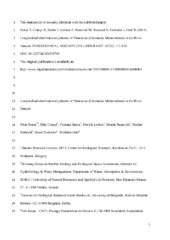Приказ основних података о документу
Longitudinal distributional patterns of Peracarida (Crustacea, Malacostraca) in the River Danube
| dc.creator | Huber, Thomas | |
| dc.creator | Leitner, Patrick | |
| dc.creator | Remund, Nadine | |
| dc.creator | Graf, Wolfram | |
| dc.creator | Paunović, Momir | |
| dc.creator | Borza, Péter | |
| dc.creator | Csányi, Béla | |
| dc.creator | Szekeres, József | |
| dc.date.accessioned | 2017-11-23T11:11:35Z | |
| dc.date.accessioned | 2020-04-01T15:54:02Z | |
| dc.date.available | 2017-11-23T11:11:35Z | |
| dc.date.available | 2020-04-01T15:54:02Z | |
| dc.date.issued | 2015 | |
| dc.identifier.issn | 1863-9135 | |
| dc.identifier.uri | https://radar.ibiss.bg.ac.rs/handle/123456789/2324 | |
| dc.identifier.uri | http://www.ingentaconnect.com/content/schweiz/fal/2015/00000187/00000002/art00003# | |
| dc.identifier.uri | https://radar.ibiss.bg.ac.rs/handle/123456789/3637 | |
| dc.description.abstract | The River Danube plays a central role in the spread of Ponto-Caspian species as a part of the so-called southern invasion corridor (Danube-Main-Rhine system); therefore, changes in its peracarid fauna (comprising the bulk of invasives) merit special attention. The latest international research expedition (Joint Danube Survey 3, 2013) offered an opportunity for updating and synthesizing our knowledge about this group along the Danube, previously based on studies covering only certain river sections and/or dealing with a subset of species. Altogether 17 amphipod, 7 mysid, 3 isopod, and one cumacean species were recorded at 55 sites investigated between Ulm (river km 2581) and the Delta. Recent large-distance expansion of additional Ponto-Caspian species was not observed, but three species (Chelicorophium robustum, C. sowinskyi, and Echinogammarus trichiatus) have been able to shorten their distributional gap in the Middle Danube, E. trichiatus being recorded for the first time in Serbia. Ponto-Caspian peracarids are still gradually advancing in the German section, as well, implying retreat of native Gammarus spp., and impeding the spread of non-Ponto-Caspian invaders. On the contrary, some Ponto-Caspian species seem to have declined in certain river sections; Dikerogammarus bispinosus was entirely missing in the Lower Danube, and several species characteristic of the lower reaches had been recorded previously much farther upstream (most notably Chelicorophium maeoticum and Obesogammarus crassus). The analysis of current and historical distributional patterns revealed that the crucial step in the large-scale spread of Ponto-Caspian species is crossing the section between Baja and the Sava estuary (rkm similar to 1480-1170) - characterized by an unfavorable combination of relatively strong currents and fine bed material - by passive transport. Presence immediately downstream of this section does not appear to promote further expansion in most of the cases; the source region of large-distance dispersal is most likely the Delta, implying that potential future invaders cannot be identified based on their previous expansion in the lower reaches of the river. | en |
| dc.language | English | |
| dc.rights | openAccess | |
| dc.source | Fundamental and Applied Limnology | |
| dc.subject | Amphipoda | |
| dc.subject | Cumacea | |
| dc.subject | Isopoda | |
| dc.subject | Mysida | |
| dc.subject | Ponto-Caspian | |
| dc.subject | Range expansion | |
| dc.title | Longitudinal distributional patterns of Peracarida (Crustacea, Malacostraca) in the River Danube | en |
| dc.type | article | |
| dc.rights.license | ARR | |
| dcterms.abstract | Хубер, Тхомас; Ремунд, Надине; Граф, Wолфрам; Леитнер, Патрицк; Сзекерес, Јóзсеф; Пауновић, Момир; Борза, Пéтер; Цсáнyи, Бéла; | |
| dc.rights.holder | © 2015 E. Schweizerbart'sche Verlagsbuchhandlung, Stuttgart, Germany | |
| dc.citation.issue | 2 | |
| dc.citation.volume | 187 | |
| dc.description.note | This is a preprint version of the following article: Borza P, Csányi B, Huber T, Leitner P, Paunović M, Remund N, Szekeres J, Graf W. Longitudinal distributional patterns of Peracarida (Crustacea, Malacostraca) in the River Danube. Fundam Appl Limnol / Arch für Hydrobiol. 2015;187(2):113–26. DOI: [http://dx.doi.org/10.1127/fal/2015/0769] | |
| dc.identifier.doi | 10.1127/fal/2015/0769 | |
| dc.identifier.scopus | 2-s2.0-84952666686 | |
| dc.identifier.wos | 000367146800003 | |
| dc.citation.apa | Borza, P., Csányi, B., Huber, T., Leitner, P., Paunović, M., Remund, N., Szekeres, J., et al. (2015). Longitudinal distributional patterns of Peracarida (Crustacea, Malacostraca) in the River Danube. Fundamental and Applied Limnology / Archiv für Hydrobiologie, 187(2), 113–126. | |
| dc.citation.vancouver | Borza P, Csányi B, Huber T, Leitner P, Paunović M, Remund N, Szekeres J, Graf W. Longitudinal distributional patterns of Peracarida (Crustacea, Malacostraca) in the River Danube. Fundam Appl Limnol / Arch für Hydrobiol. 2015;187(2):113–26. | |
| dc.citation.spage | 113 | |
| dc.citation.epage | 126 | |
| dc.type.version | submittedVersion | en |
| dc.identifier.fulltext | https://radar.ibiss.bg.ac.rs/bitstream/id/6086/BorzaP_etal_FAL_ms.pdf | |
| dc.citation.rank | M23 |

